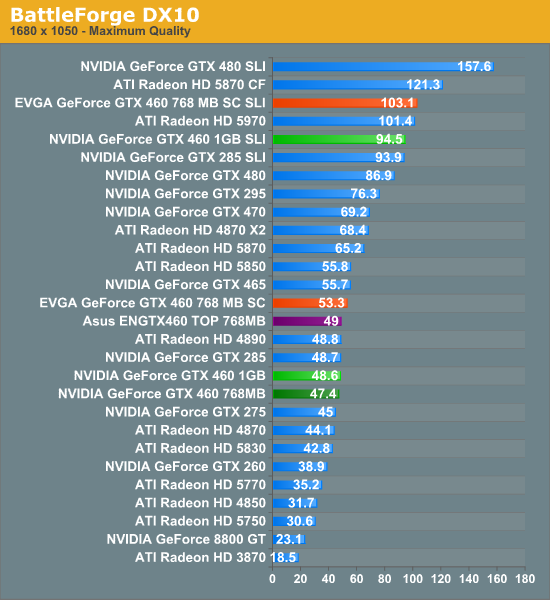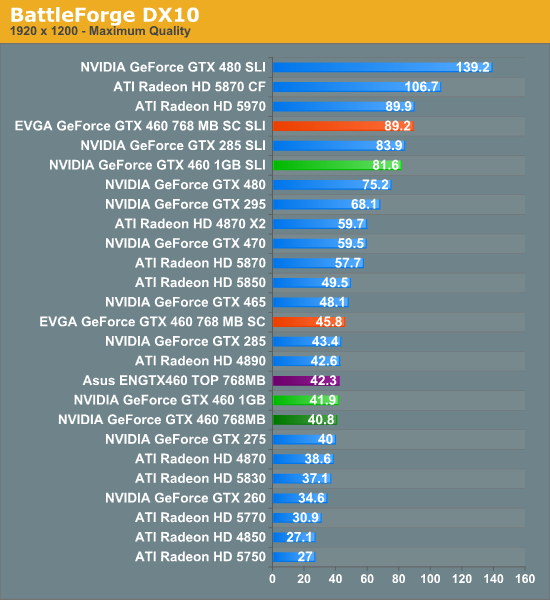NVIDIA’s GeForce GTX 460: The $200 King
by Ryan Smith on July 11, 2010 11:54 PM EST- Posted in
- GPUs
- GeForce GTX 400
- GeForce GTX 460
- NVIDIA
BattleForge: DX10
Up next is BattleForge, Electronic Arts’ free to play online RTS. As far as RTSes go this game can be quite demanding, and this is just at DX10.



BattleForge switches things up some. No longer are we RAM/L2/ROP dependent as much as we are on raw shader power. This gives the 1GB GTX 460 only the slightest advantage over the 768MB card, while the factory overclocked cards clearly dominate here.
This also gives us a situation where we can gauge the GTX 460 and GTX 465 in a shader-bound test and see just how well the GTX 460 can do. The result in the favor of the GTX 465 by quite a bit, where it beats the 1GB GTX 460 by nearly 15%. With the need to extract ILP from the GF104 GPU to fully utilize the GPU’s CUDA cores, this looks to be approaching a worst-case scenario for the GTX 460, as it even falls behind last year’s GTX 275 and Radeon HD 4890.
As for the Radeon 5000 series, AMD’s situation improves here. The 5830 still loses, but only by 10%. Meanwhile the 5850 pulls ahead of the 1GB GTX 460 by 18%.










93 Comments
View All Comments
Howard - Monday, July 12, 2010 - link
What?Zok - Monday, July 12, 2010 - link
Excellent writeup! I really enjoyed you going into depth on the architectural changes. I couldn't agree more that it's superb to see NVIDIA get back into the efficiency game - whether it be performance/price or performance/watt (and, by extension, temperature). Here's to hoping that AMD was sitting on something to combat this!P.S. Small typo: For everything but the high-end, this year is a feature yet and not a performance year.
thekimbobjones - Monday, July 12, 2010 - link
Let the price war begin.homerdog - Monday, July 12, 2010 - link
"Here we use the DX11 renderer and turn on self shadowing ambient occlusion (SSAO) to its highest setting, which uses a DX11 ComputeShader."I don't think that's what SSAO stands for. Sorry for the nitpick.
chizow - Monday, July 12, 2010 - link
Yeah I believe the proper term is Screen Space Ambient Occlusion but self shadowing is how its often explained to give an idea of what it is.gentlearc - Monday, July 12, 2010 - link
The graphs shown are leaving out too many new derivatives of cards, making is good for contrasting results, but poor for consistent data comparison. Conveniently left out are many cards in one graph that are in another. I'm disappointed in your presentation and find you've concentrated too much on the presentation of your article.Ryan Smith - Monday, July 12, 2010 - link
Out of curiosity, what's not in our graphs that you'd like to see? At 2560 we run a limited number of cards because most cards are too slow to post a passable framerate, otherwise at 1920 and 1680 we have the complete 5700/5800/5900 series, GTX 400 series, GTX 200 series, and Radeon 4800 series, along with a 3870 and 8800GT. Is there something else you would like?SpaceRanger - Monday, July 12, 2010 - link
What I'd like to see is the ATI card that is in direct competition with this highlighted as well. Having to search for the 5830 or 5850 out of all those bars turned me off.estaffer - Monday, July 12, 2010 - link
need some cheese with your whine?SpaceRanger - Monday, July 12, 2010 - link
Sure.. a good Gruyère please...